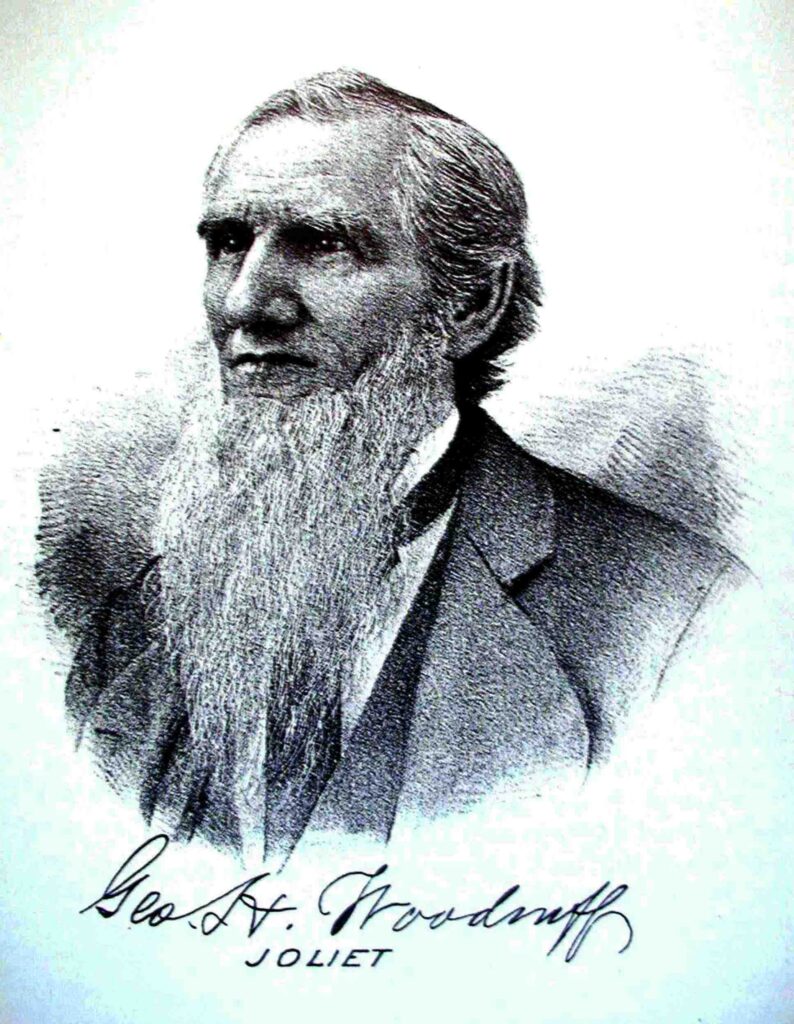What George remembered, a portal into the past

What did it look like to the first ones? The first few white men to come to this area saw a very different landscape than we do, that is for sure. And while Braidwood was settled by white men some 30 years later, I imagine the scenes were very similar to 1834. There are no photos, but we do have memories put to paper.
One man who did so with great skill and humor was George Woodruff. Set the way back machine to Joliet, Dec. 17, 1878, so we can listen in on his lecture about his very early days. We have arrived just as George is describing why and how he traveled to what would become the county seat — Joliet:
“In June of 1834, M. H. Demmond, from Herkimer County, N.D., in company with George R. Makepeace, on an exploring tour, came down from Chicago, and were so well pleased with the prospect of McKee’s town (Joliet), that each purchased one of his acres for $125. They returned to New York, settled up their business, and with their families came hither in the latter part of September. Miss Murray, a sister of Mrs. Demmond, a young man by the name of Jenney, and myself, accompanied them.
“The journey occupied us two weeks. From Detroit we came through to Niles (Michigan) by stage – a rough and tedious experience, the roads being through a new and heavily timbered and swampy country, were bad enough. At Niles we hired teams to bring us through to ‘Juliet.’
“As we came on, the roads grew much better, as the character of the country grew more rolling. But there was but little settlement, and the cabins grew less frequent as we came west, and the road became a mere trail. But we were in no danger of losing our way, for we followed near the famous “Sauk trail.
“At long intervals the smoke of a pioneer’s cabin under the lee of some sheltering grove, gave indication of human settlement. It was a lonesome grove, gave indication of human settlement. It was a lonesome and yet a delightful ride, for the weather was fine, and everything was a new experience. The prairies, unlike the level monotony of those we had passed in Michigan.
“The groves, unlike the dense and swampy forests we had toiled through, look more like the parks and orchards of some old and cultivated land, while at every step, flowers strange and beautiful, greet the eye. The prairie-hen starts up from the grass, and from the oak openings the antlered deer gazes at us with more of wonder than of fear. A strange haze mellows the rays of the cloudless sun, and gentle breezes, untainted by the breath of city or hamlet, regale us with the perfume of unshorn fields and countless flowers.”
George does tend to ramble, so let us skip to his description of how supplies were obtained and where they came from:
“As a matter of course, for the first few years, we were mainly dependent upon older settlements for our supplies. These were brought mostly from the ‘Wabash.’ (Indiana) This region, somewhat indefinite perhaps, was a kind of nursing mother to the northern part of our state.
“Flour, bacon, cornmeal, dried fruit and whitewood siding, were the principal articles of commerce. These were transported in those curious and capacious old wagons, which originated, I believe, in Pennsylvania, but which we used to call ‘Hoosier wagons,’ or ‘Prairie schooners,’ and which, with their canvas covers and long ox teams, traveling in company, reminded one of the caravans of the east, as they slowly moved over the unobstructed prairie.
“A curious specimen of humanity, too, was the driver, armed with his long whip, which he cracked with a noise like the report of a pistol, as he sat perched up in the bow of his schooner, or plodded his way beside his cattle, clad in butternut jeans, his face, hands and feet about the same color as his ‘bacon.’
“This ‘bacon’ by the way, was a curious product. It consisted of the ‘sides’ of the hog, with the ribs removed and cured by salt, in stacks, then smoked a little, and was handled loose and unprotected by any kind of package or cover. It thus became exposed in summer to the flies, and was often well stocked with maggots.
“In this state it was not particularly relished by Yankees, and before offering it for sale, it is said to have been the custom to stop outside of town and subject it to the section of smoke, with sufficient heat to cause a stampede of the maggots. I suppose after a week or two at Andersonville or Libby (Union prison camps during the Civil War), one would not be so fastidious!
“The Hoosier and his team traveled in entire independence of taverns. His capacious wagon carried his supplies for the journey. His wants were simple. Cornmeal and bacon, coffee and tobacco, and most likely some whiskey, formed the ‘common doings’ with which he was content. And for his cattle he carried some corn, and allowed them to feed upon the rich herbage of the prairie night and morning.
“Camping by a spring or brook near the timber, he made his coffee with water from the spring, and toasted his bacon by a fire of faggots (bundles) gathered from the woods, and now and then, when these were hard to find, a rail or two from the settlers’ fence. He slept at night under his canvas cover, secure from rain and dew.”
Here we leave George, but we will visit him again soon, as he is our “portal into the past” of Will County history.
Sandy Vasko is Director of the Will County Historical Museum & Research Center and President of the Will County Historical Society.